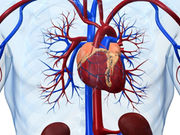Risk associated with no revascularization consistent in subgroup analysis, including older age
FRIDAY, June 24, 2016 (HealthDay News) — Mortality is increased for patients with non-ST-segment elevation myocardial infarction (NSTEMI) who do not undergo coronary revascularization, according to a study published in the July 1 issue of The American Journal of Cardiology.
Alex Blatt, M.D., from the Assaf Harofeh Medical Center in Zerifin, Israel, and colleagues examined the clinical characteristics, management strategies, and outcomes of 3,198 patients with NSTEMI. Patients were categorized into three groups: no catheterization (no angio), catheterization with revascularization (angio-revascularized), and catheterization without revascularization (angio-nonrevascularized). Seventy-nine percent of participants underwent coronary angiography performed during the index hospitalization, 59 percent of whom underwent revascularization.
The researchers found that the rate of administration of evidence-based therapies at index hospitalization was significantly higher for the angio-revascularized group compared with the other groups. Patients in the no-angio group experienced significantly higher risk for one-year mortality compared with those in the angio-revascularized and angio-nonrevascularized groups (hazard ratios, 2.04 and 1.21, respectively). In each risk subset analyzed, including older age and increased creatinine levels, there was consistent risk associated with no revascularization.
“In conclusion, our data, from a large real-world contemporary experience, suggest that patients with NSTEMI who do not undergo coronary revascularization during the index hospitalization represent a greater risk and undertreated group with increased risk for long-term mortality,” the authors write.
Copyright © 2016 HealthDay. All rights reserved.








